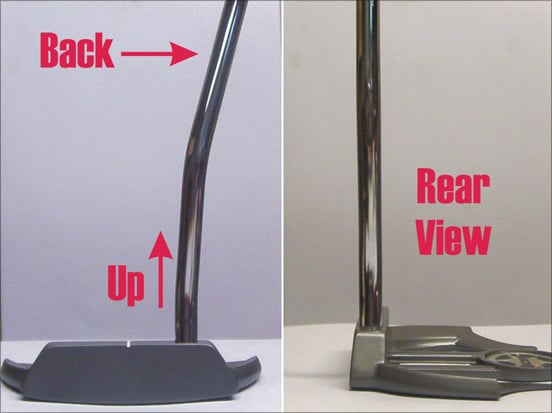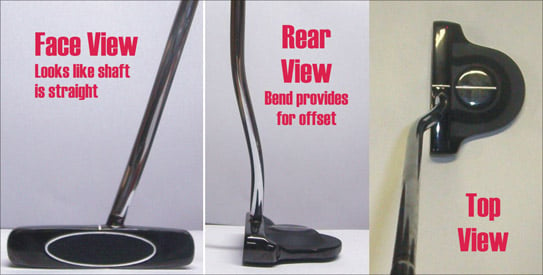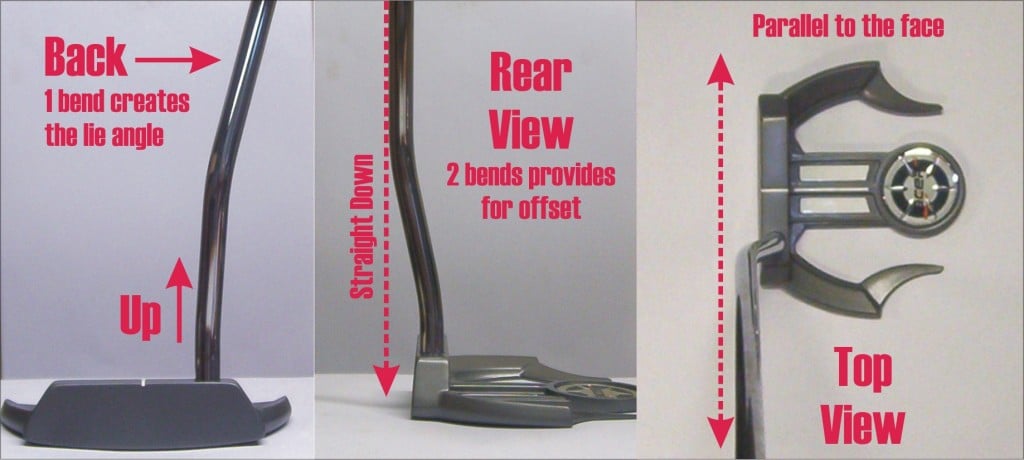How To Align a Curved Putter Shaft
Anatomy of a Golf Putter Head
For beginning clubmakers, one of the more daunting tasks is to properly install and align a curved putter shaft into a putter head, but it doesn’t has to be. Curved or bent shafts exist for only one club in the bag and that is a putter, while all other clubs are required to use straight shafts, including chippers. The purpose of a curved putter shaft is either to create an offset, a specific lie angle or even both when properly installed. Many of these shafts are for putters with a socket in the head, but there are also models where the putter shaft fits over a post (also known as a tang or spud).

Installing a bent putter shaft in a putter head is actually a very simple process. In all honesty, you can install the shaft virtually any way you want, but there is only one best way to do so for each putter. Visual perception is a key to proper installation – in other words, if it looks “right”, it probably is “right!” Before we get started, there are three different types of bends that need to be discussed.
Single Bend Putter Shaft
The simplest bend to explain is the single bend putter shaft. It is designed primarily for a putter which the hosel bore is 90 degrees or perpendicular to the ground. The Rules of Golf stipulate that the lie must diverge from the vertical by at least 10 degrees. Most single bend putter shafts diverge by close to 18 degrees to create a 72 degree lie angle or one that is fairly standard in the industry.
Installation is as follows: the shaft as it exits the socket or post will come straight up, then curve back toward the heel of the putter or back toward the player. The rear view look like the shaft is straight when in fact the shaft is curved back. If you incorrectly install the shaft, it will be apparent the face angle is either open or closed at address.
An example is Apollo's Single Bend putter shaft.

Double Bend Putter Shaft
The next type of curved shaft is the double bend putter shaft. It is designed strictly to create an offset to the putter. The putter that will use a double bend shaft will already have the lie angle bored into the socket or built into the post, but with the offset, the hands are pressed forward. Often times the double bend shaft is used instead of a straight putter shaft.
To install the bends properly, the shaft will first come straight out of the socket or the post as in this case, then bend toward the face or the target, then back up again. From the front view it will look as the shaft is straight. If you are a little off in the alignment it won’t be as critical as the other two bends and the lie will remain the same. The most significant parameter that will change is the amount of offset the putter will have. An example is Apollo's Double Bend putter shaft.

Triple (Compound Double Bend Putter Shaft
The most confusing of the bent shafts is the compound double bend putter shaft or also considered a triple bend putter shaft. It is designed to create both the lie angle and the offset of the putter whose bore is 90 degrees. This is one example where a shaft can be designed only for right or left handed putter, but not both.
To install the bent putter shaft properly, the shaft will first come up straight out of the socket or post, then bend toward the face or the target, then back up again, then finally back toward the heel.
If the shaft is installed incorrectly, the portion of the shaft above the bends will not be parallel to the face creating a face angle that will not be square to the target.
An example is the Apollo’s Triple Bend putter shaft. Note: these are for either right or left hand putters, but not both.

Proprietary Bend Putter Shafts
Some name brand putters may take a single or a compound double bend shaft and install it slightly different. The most famous of all is the shaft found in the old Odyssey 3 ball putter. That is, instead of the the post being perpendicular the ground, it was angled intentionally toward the toe to create a face balanced situation in concert with their proprietary bent shaft.
Shaft manufacturers like True Temper may have hundreds if not over a 1000 shafts they have made with a proprietary bend for a particular putter head. Almost all of those were only available to the that manufacturer and not available for resale by any of the component companies. In cases were the shaft breaks in one of those models, the clubmaker may advise the customer to send it back through an authorized dealer. In certain cases, the clubmaker may be able to re-create the bend with one of the shafts available through component suppliers like Hireko and make modifications with a special putter shaft bending bar.
Build a putter with confidence
Curved putter shaft assembly is fairly straightforward once you understand the basics. Now you know the differences between single, double and triple bend putter shafts and their applications. Hopefully today’s tip will take all that fear out of curved shaft putter assembly!

